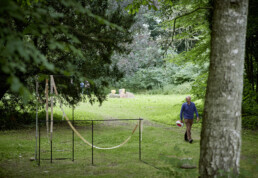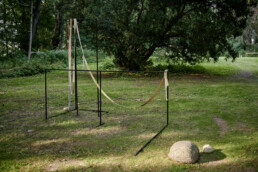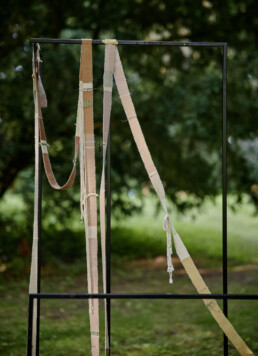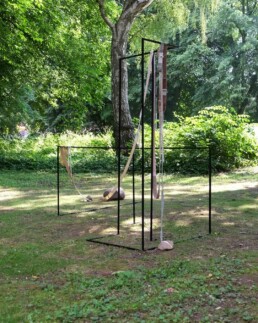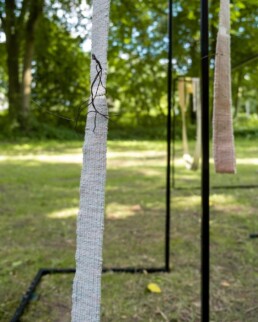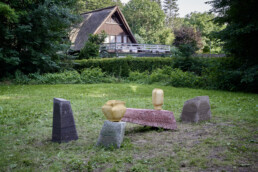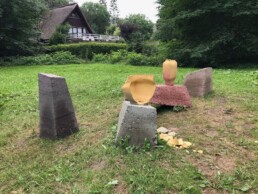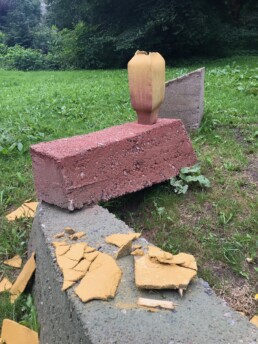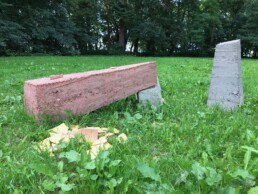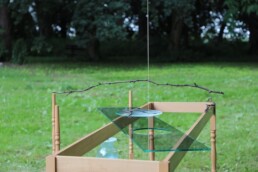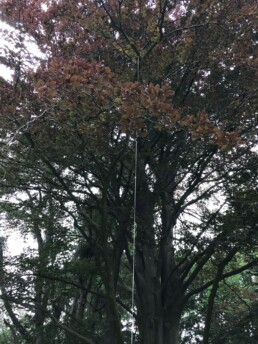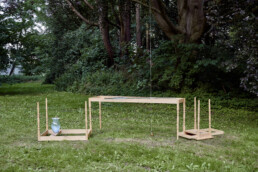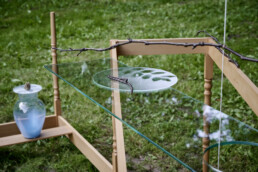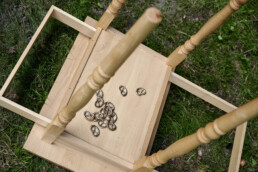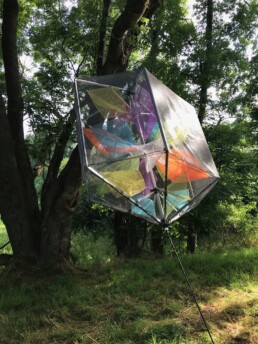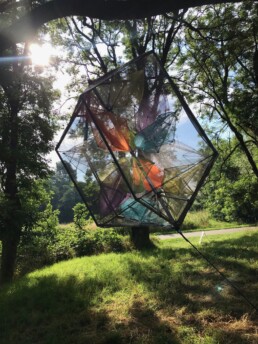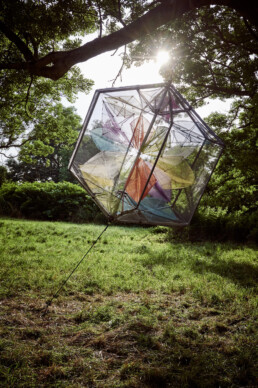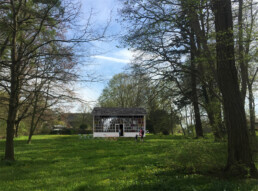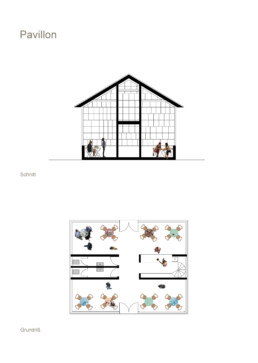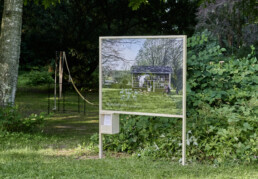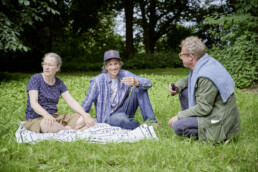22
2021
Under the banner PLAY MUSEUM, SCHMUCK2 picked up the focus on architecture and jewellery from its previous project and developed a utopian contemporary „(jewellery)museum“. This project concerned itself less with planning a new building and more with drawing the vision of a museum with a series of artistic installations, actions and new digital presence.
© Thomas Häntzschel/nordlicht
With the installation of the HOCHsitz as a »hypertransmitter« (Glashagen MV) and the associated »HOCHsitzen« publication of interviews in 2010, SCHMUCK2 posed the question of the contemporary location for artistic production and action. In projects such as PLAY JEWELLERY – WEAR ARCHITECTURE: Thinking about jewellery through architecture« (Tokyo 2015) or »THINK BAUHAUS: Building Jewellery in Architecture« (Halle and Tokyo 2019), SCHMUCK2 has iteratively juxtaposed architecture and jewellery in relation to each other. The theory that architecture stands symbolically as an ornament for its surroundings (Toshimasa Sugimoto/Architectural Historian) developed finally within this discourse.
With the pandemic in the background, the ways in which we install and organize exhibitions are changing, as well as how we receive and experience them. The new forms in which content is presented — digital/real, global/local, sustainable and participatory — are also changing the architecture in which this presentation takes place: it is moving from a fixed fortress to a flexible action. In the case of PLAY MUSEUM, the architecture — the designed and bounded space — is now lost in the action, turning its role from lodge to lodger.
Keeping the format of a classical exhibition, the artists Caroline Bayer, Kai Schiemenz, Asako Shiroki, Stefan Wischnewski, as well the architect Tom Kühne, developed and installed „architecture“ or „architectural gestures“ in the midst of the Mecklenburg landscape — in the park of the old Glashagen estate and next to the HOCHsitz that, following Sugimoto’s proposal, can be interpreted as jewellery.
© Caroline Bayer, Thomas Häntzschel/nordlicht
Caroline Bayer
STREAMER / plant-dyed wool (Xanthoria Parietina, Salix Salix), found objects, foundlings, powder-coated steel / 2021
For the work Streamer Caroline Bayer worked with the locally found lichen Xanthoria Parietina. In fermentation processes lasting several weeks, this lichen reacts similarly to indigo when dyed: shades ranging from light pink to pink can be achieved on wool.
Bayer took advantage of this and then wove the dyed wool into long ribbons, which she placed almost decoratively in a fragmentary spatial situation made of steel. The implied architecture functions as a linear drawing in space. It was created in reference to the modular display system Leger und Träger developed by the architect Friedrich Kiesler in 1924. It makes it possible to present exhibits without the aid of walls and to realize exhibitions independently of the room. Bayer took up Kiesler’s design and developed a system of linear steel modules that can be repeatedly assembled to create new forms and spaces.
© Susan Pietzsch, Thomas Häntzschel/nordlicht
Kai Schiemenz
Ane Titec (im Park)/ gravel, soil, clay, pigments / 2021
„A small park with trees. A meadow where there was a manor house. A path passes by it, which itself does not provide access to it. The park is embedded in a landscape of meadows, fields and farmsteads. In the movement of its paths dwells a little theater, a movement that visitors follow. If we see the park as a museum that collects and sorts things, then the meadow speaks of the absence of the manor house.“ (Kai Schiemenz 2021)
Kai Schiemenz has created an ephemeral and equally sustainable sculpture on site from clay, earth, gravel and pigments. Water was added to compact molds in formwork, which, once removed, served first and foremost as a display for unfired vessels made of clay, shaped by the artist. At the same time, the tamped earth was weather-dependent and thus subject to a natural process of decay.
The ephemerality became part of the sculpture and thus recalled the history of the site.
According to Schiemenz, it is not possible to say unequivocally in this regard whether the process of bringing forth and that of decay is not the actual sculpture.
© Asako Shiroki, Thomas Häntzschel/nordlicht
Asako Shiroki
A twig of interweaving passages / wood, glass, silver chain, bronzes / 2021
„One day I was walking on the street, I found charming shapes of the twigs. As I had one of them in my hand, I spotted a bird’s nest over my head. It was the moment of intervening between rational collection and destined accumulation, and it was the moment of discovering passages and interweaving different worlds. A charming shape of the twig was the connection of autonomous existence. I felt that we exist in our time with many different layers of the world.“
In her work, Asako Shiroki dislocates mutual rules and assigns new relationships to events that occur simultaneously in this world. History and culture, customs, awareness of flora and fauna, also the physical phenomena between tangible and intangible things are twisted and mixed by her. She reverses and mix things-including concepts-that by rights ought to be on the reverse, reflect things in mirrors, or peel away related meanings to let things themselves start a dialogue in different contexts. Different languages are translated, folded and layered with fictions and realities in a moment that leads us to a world in which they are equated.
Not without reference to the immediate environment, the artist has turned museum content on its head for PLAY MUSEUM, without neglecting concepts such as beauty and poetry against the actual background of the project.
© Susan Pietzsch, Thomas Häntzschel/nordlicht
Stefan Wischnewski
Interspace / laundry spiders, fly hoods, mosquitonets, aluminium / 2021
The seemingly floating sculpture made of laundry spiders, fly hoods and mosquito netting is already by its material origin, naming and function on the interface between nature, animal and man. The synergistic effect of a semi-transparent appearance in this rural environment sharpens the perception on the place, which is transformed into an open air showroom. The encounter with the self-contained net sculpture and the artificial complimentary colored fabric objects moving inside, allows a closeness at a distance, familiar from museum spaces.
© Tom Kühne, Thomas Häntzschel/nordlicht
Tom Kühne
Wandelhalle Glashagen – an architectural vision for the park of the old Glashagen estate / 2021
Using the means of looking back at the history of Glashagen-Hof, taking stock and formulating the potential available on site, Kühne developed the vision of a meeting/exhibition/event venue for, among other things, regional building culture in the form of a pavilion with coffee facilities on the vacant site of the former manor house.
© Thomas Häntzschel/nordlicht, Inga Knölke
> Play Museum proposes the museum as an argument, with an architecture made of theory: flexible, volatile, undulating and capable of sheltering, hosting and generating content to put it into reality.
The diagram shows a step-by-step dynamic management of actions defining the areas of performance and influence, with the intention of promoting architecture and jewelry in a critical and speculative setting to generate working models. In the pages of the book >Play Museum an initial drawing advances towards a diagram and ends up as a map of the museum on a picnic blanket.
Diagram of the >Play Museum concept by Martí Guixé as a map of the museum on a picnic blanket.
© Studio Martí Guixé
The project PLAY MUSEUM was funded by the Stiftung Kunstfonds within the program NEUSTART KULTUR, supported by Makra Bau GmbH and the municipality of Retschow.
